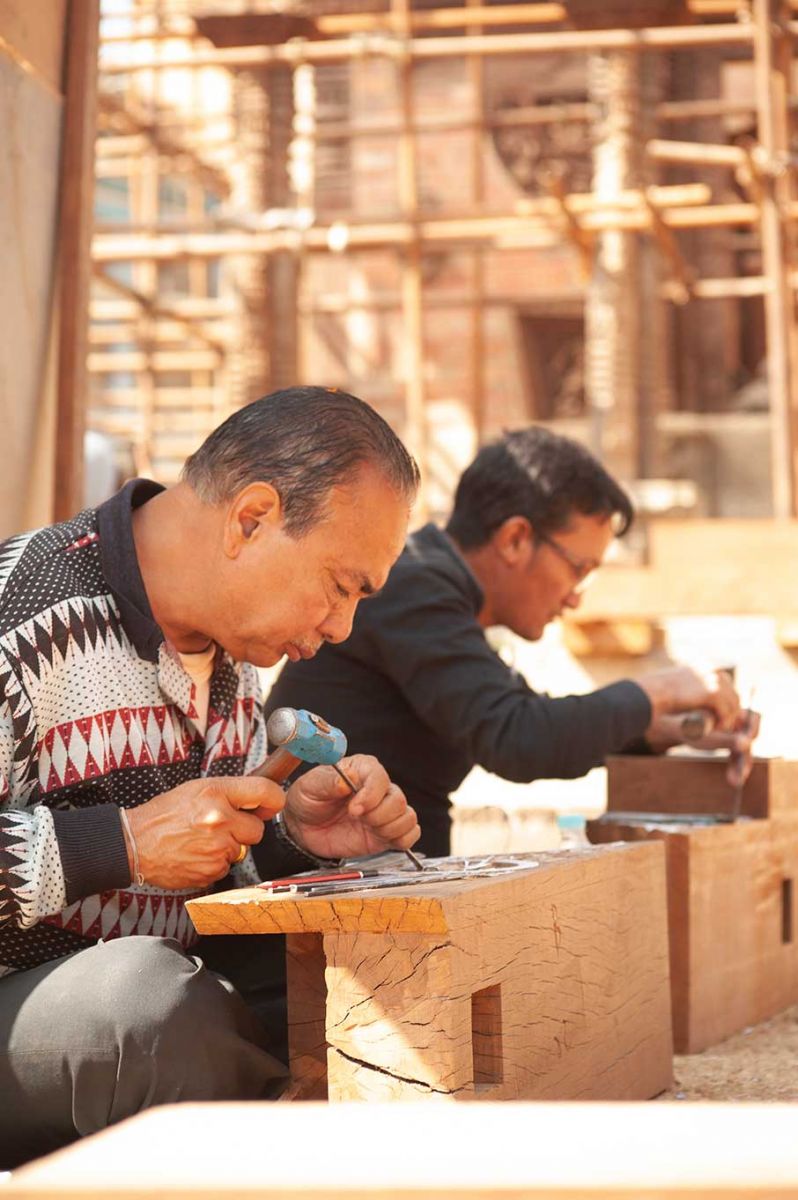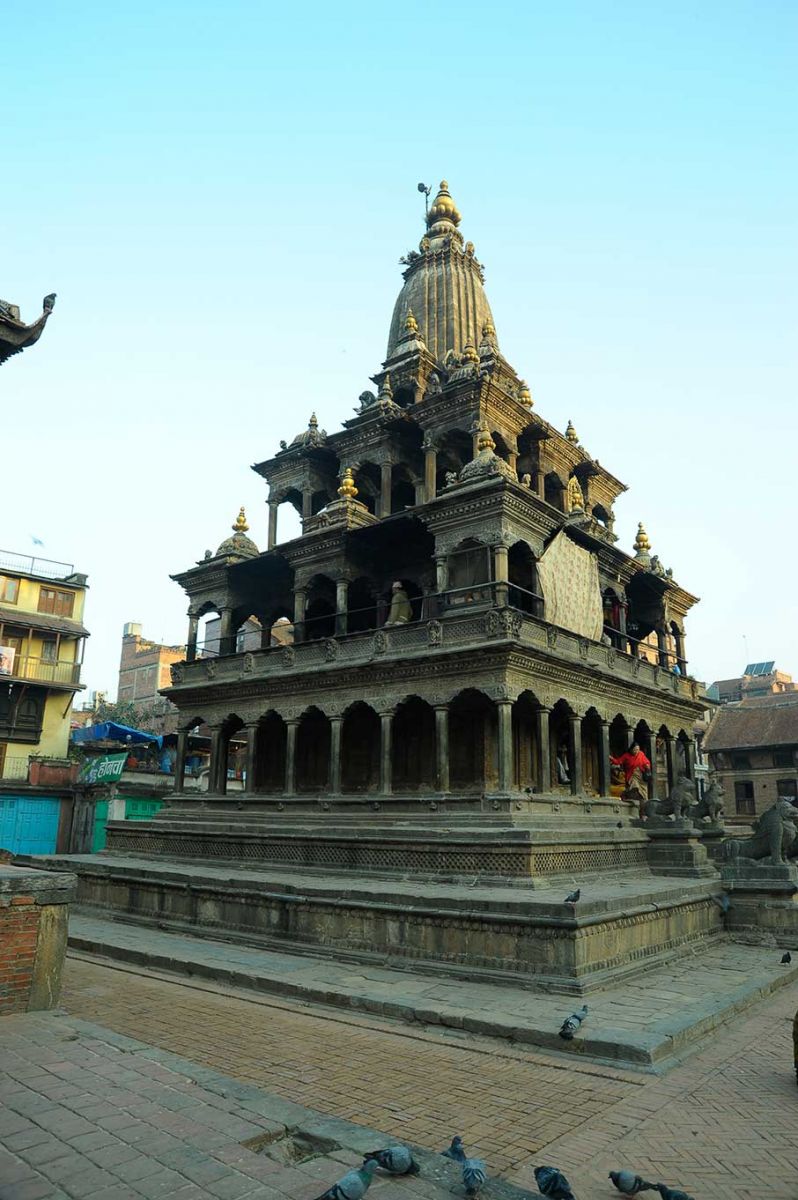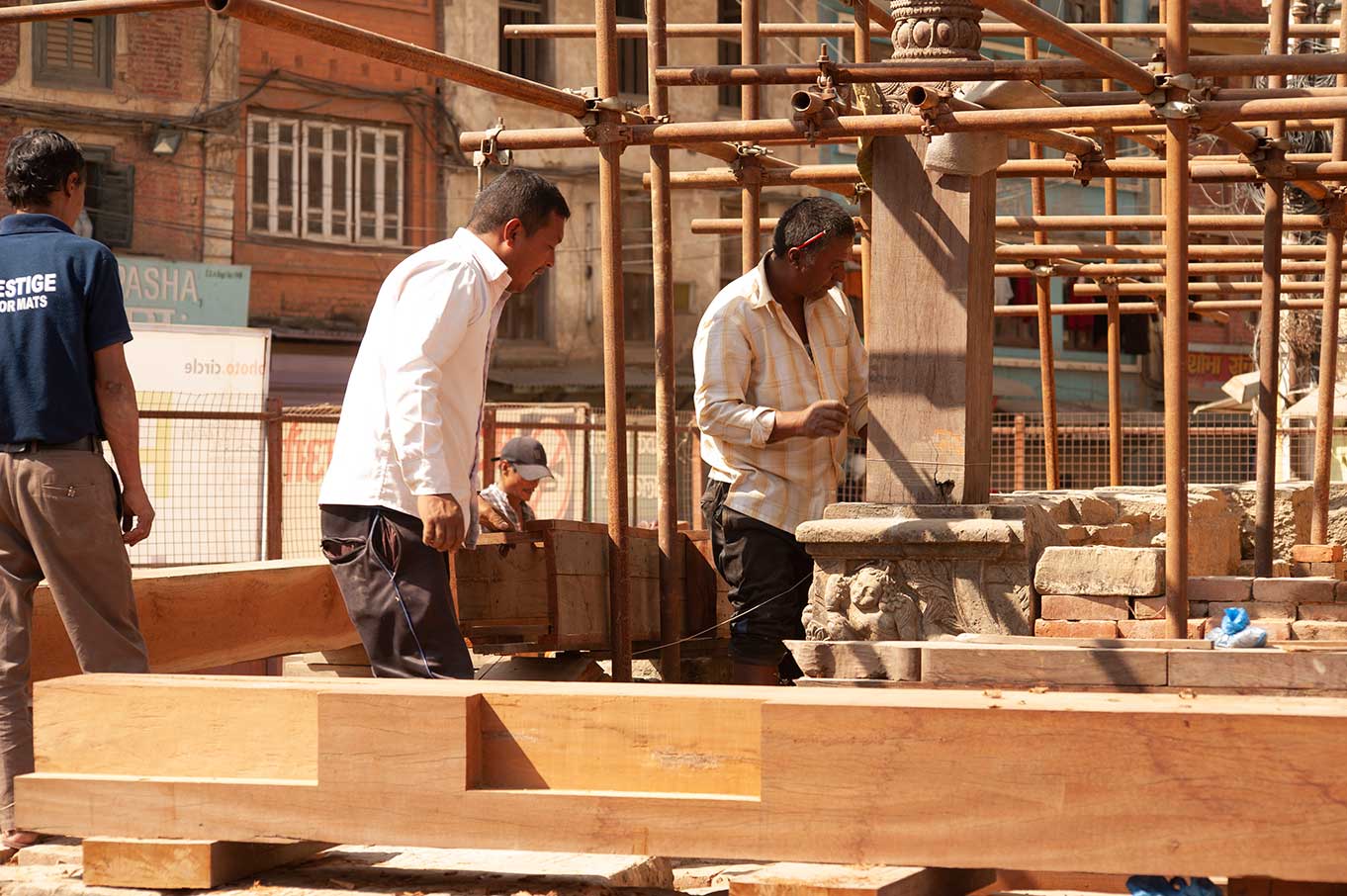
Patan is believed to have been made in the third century BC by the Kirant dynasty, who despite their rule of 1225 years did not leave any remarkable traces behind. What we now know as Patan was designed by the Lichhavis and the Mallas, for whom art was the halo of their rule.
No matter where I travel in the world, when in Kathmandu, I make sure to visit the area around Patan. It is one of my favorite spots to spend such lovely evenings, either in the Durbar Square or in Pimbahal Pokhari. This was a regular evening—I wait for my friends to arrive. The city was gleaming as usual; this façade of Patan has been full of life since the fourth century. I walk through the square, and a profound sadness hits me, reviving memories of the tremors that shook the country. Everything had collapsed, and especially, heritage sites suffered the most. It’s almost been three years since the earthquake, and yet, Patan is still on the path to be restored. Sometimes I wonder, why is it taking so long? Why three years? When will this place be the same? But, I register that it is unimaginable to restore such carefully designed wood and metal carvings without missing a single intricate detail. Thinking about this made me content, and after all, it’s about creating values. It is the quality that matters.
 Restoring monuments and temples as they were in the primeval era is a challenge. Recreating pieces of such labyrinthine details entail a large amount of time and dedication. The exotic designs in wood and stone sculpture are proof that exquisite craftsmanship dates back to the first century. Wood and metal craft has been thriving since the Lichchavi period. Though there are not many evidences of carvings from that period, it is from the Malla era that architecture began to bloom and reached at its peak of perfection. Even the smallest pattern you see represents a story or a very unique reasoning as to why certain details are placed in a specific manner. Today, as you walk through the square, you no longer see rubble, but scaffoldings, and some temples and monuments still standing in full glory. Looking at that sight, it is like a recurring dream; the mysterious wooden temples and ringing of the bells remain etched in my memory.
Restoring monuments and temples as they were in the primeval era is a challenge. Recreating pieces of such labyrinthine details entail a large amount of time and dedication. The exotic designs in wood and stone sculpture are proof that exquisite craftsmanship dates back to the first century. Wood and metal craft has been thriving since the Lichchavi period. Though there are not many evidences of carvings from that period, it is from the Malla era that architecture began to bloom and reached at its peak of perfection. Even the smallest pattern you see represents a story or a very unique reasoning as to why certain details are placed in a specific manner. Today, as you walk through the square, you no longer see rubble, but scaffoldings, and some temples and monuments still standing in full glory. Looking at that sight, it is like a recurring dream; the mysterious wooden temples and ringing of the bells remain etched in my memory.
As my eyes swerve across the beautiful square, my mind darts to the kings who made them, to the hands that perfected the tiny arcs in the windows, the peaceful face of the idols, and the majestic pagoda architecture of the temples. Patan is believed to have been made in the third century BC by the Kirant dynasty, who despite their rule of 1225 years did not leave any remarkable traces behind. What we now know as Patan was designed by the Lichhavis and the Mallas, for whom art was the halo of their rule. The palace that was home to all the kings of Patan is now a museum with a collection of artifacts.
There are also four famous stupas built by Emperor Ashoka in 250 BC, one each at the four corners of the city. Often called the most Newari city, Patan is a vibrant mélange of cultures, and with a host of funky little cafes and restaurants, it becomes perfect for creative ramblings. The emergence of Patan as a significant center of commerce, ideas, and culture was undeniably the Licchavis’ supreme achievement. Patan remained a hugely important channel, until the valley capital was shifted to Kathmandu with the arrival of King Prithivi Narayan Shah. But, it never saw the historical glory days that Patan did.
Even after all these years of urbanization around the square, Patan stands with pride and has been an inspiration to other heritage sites. Then, on April 25, 2015, it all came crashing down. It was like a dark cloud that loomed over the city. Tremors shook the ground, and buildings that were rooted to the ground moved violently along side. Centuries-old temples crashed with a loud roar, leaving behind only thick clouds of dust, losing their meaning, stories, and history that could educate generations to come. The immediate curiosity that was generated by this circumstance led to people wondering how and when we would, if ever, restore these beautiful lost temples to their former grandeur.
 As I walked into the mystical square, I see people at work. You can hear saws making their way through wood, giving them shape, and carpenters installing windows and doors. Many heritage sites either collapsed or were structurally weakened. The oldest temples, Char Narayan and Hari Shankar, along with two paatis, collapsed completely. Together, Kathmandu Valley Preservation Trust (KVPT), Patan Museum and the Department of Archaeology assembled all the parts—windows, beams, doors, etc.—a few days after the quake. Not a single part was neglected; even broken and disassembled pieces were collected and stored.
As I walked into the mystical square, I see people at work. You can hear saws making their way through wood, giving them shape, and carpenters installing windows and doors. Many heritage sites either collapsed or were structurally weakened. The oldest temples, Char Narayan and Hari Shankar, along with two paatis, collapsed completely. Together, Kathmandu Valley Preservation Trust (KVPT), Patan Museum and the Department of Archaeology assembled all the parts—windows, beams, doors, etc.—a few days after the quake. Not a single part was neglected; even broken and disassembled pieces were collected and stored.
All these broken parts are being put together with the help of traditional craftsmen. “We have documentation of the temples, which we use as reference while rebuilding them. The photographs will help to figure out which piece goes where, and with which,” says conservation architect Dr. Rohit Ranjitkar, Nepal Program Director of KVPT. “After the earthquake, the locals, the army, Patan Museum, Department of Archaeology, and us worked as a family to collect all the broken parts of the temples and made sure to assemble them in a safe place. Then, we segregated the different elements of the temples and monuments.”
Explaining further, he adds, “All the pieces were similar, so every time we collected a piece we made sure to mark the temple, so that it would let us know where parts go while restoring. It is difficult to create the exact details of the architecture of the temple. We do not have the same craftsmanship that created these exquisite pieces. Their working style was vastly different from how the craftsmen work today. For instance, we use iron nails to join two pieces of wood, while they used wooden chukuls.”
KVPT was the sole organization that acted quickly for the restoration and protection of these monuments, while the government and other organizations were struggling to find a starting point. The trust has thus set an example. No matter how overwhelming and impossible it seemed at the very beginning, they moved forward to protect the centuries-old artifacts from the rubble, proving that it just takes a step to start the work. However, even after three years of the earthquake, the work done by them has only been appreciated by outsiders. What we do not see is the constant behind-the-scene efforts of the trust, which ran around to various government offices to receive confirmation to restore these temples, which were under the government’s ownership.
 As soon as the problem of slow government work settled down, a striking query about the authenticity of the craft arose. People were curious about who would be able to reproduce the exact details of the centuries-old temples—one of the reasons why the decisions regarding even the best-of-the-best procedure consumes so much time. Individual opinions also varied greatly. Restoring these temples is definitely a time-consuming job, as it needs to satisfy every party, from architectural bodies to the local guthi. Fortunately, when it comes to financing the restoration work, they are in a stable position, with help from donors around the world like the British Embassy, American Embassy, US Ambassadors Fund for Cultural Preservation, Embassy of Japan, and many more. However, finding skilled craftsmen is a problem. As Dr. Ranjitkar says, “We cannot find craftsmanship like of those who built these monuments. We can recreate it, but the working methods in those days and how workers do it now is nowhere close.”
As soon as the problem of slow government work settled down, a striking query about the authenticity of the craft arose. People were curious about who would be able to reproduce the exact details of the centuries-old temples—one of the reasons why the decisions regarding even the best-of-the-best procedure consumes so much time. Individual opinions also varied greatly. Restoring these temples is definitely a time-consuming job, as it needs to satisfy every party, from architectural bodies to the local guthi. Fortunately, when it comes to financing the restoration work, they are in a stable position, with help from donors around the world like the British Embassy, American Embassy, US Ambassadors Fund for Cultural Preservation, Embassy of Japan, and many more. However, finding skilled craftsmen is a problem. As Dr. Ranjitkar says, “We cannot find craftsmanship like of those who built these monuments. We can recreate it, but the working methods in those days and how workers do it now is nowhere close.”
 As an outsider, I could not help but wonder why the government had refrained so much from the restoration of the temples that are under their ownership, and which they can easily finance from the fund created by the US10$ fee received from all foreigners who visit the square. This naturally raises the question, “Where does all the money go?” Though the law restrains the government from giving finance to non-profit organizations like KVPT, the issue arises, as the government has not done any direct work from its budget to repair these monuments. The fact is that many people depend on these monuments, which attract visitors easily. These temples and monuments are embedded with our identity and meaning and must be restored, as they are a window for everyone to look back at the difficult times we faced, and is a representation of the dreams of our forefathers.
As an outsider, I could not help but wonder why the government had refrained so much from the restoration of the temples that are under their ownership, and which they can easily finance from the fund created by the US10$ fee received from all foreigners who visit the square. This naturally raises the question, “Where does all the money go?” Though the law restrains the government from giving finance to non-profit organizations like KVPT, the issue arises, as the government has not done any direct work from its budget to repair these monuments. The fact is that many people depend on these monuments, which attract visitors easily. These temples and monuments are embedded with our identity and meaning and must be restored, as they are a window for everyone to look back at the difficult times we faced, and is a representation of the dreams of our forefathers.










